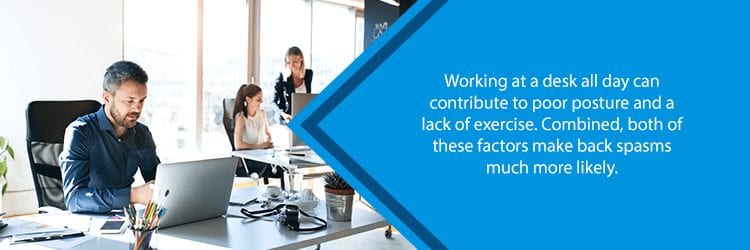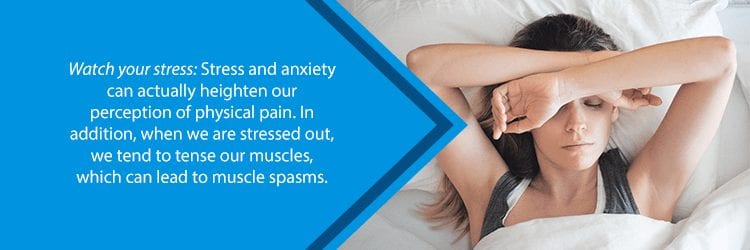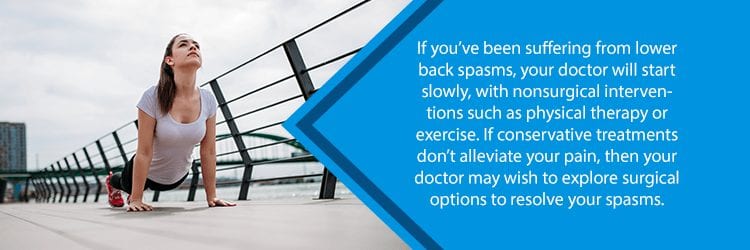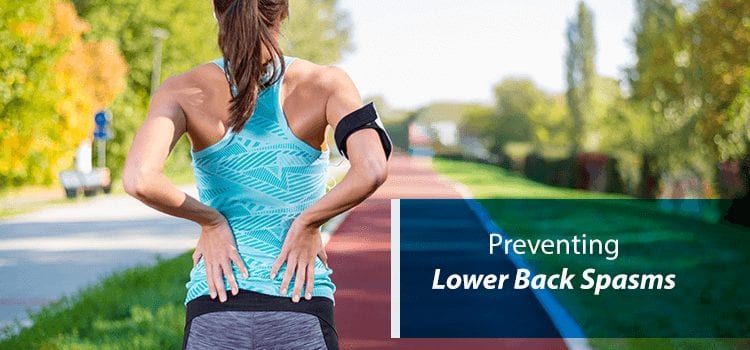There are many possible causes for why people experience lower back spasms. Such culprits include muscle overuse, poor posture, and strains from heavy lifting. Sometimes, the spasms and accompanying pain recur or worsen over time. In such cases, it is important for the patient to see a doctor for an assessment as soon as possible.
Lower back spasms feel like the muscle is firmly moving and/or contracting. That being said, a lower back spasm may also feel like a dull ache that moves. In addition, other people may notice a sharp pain in a specific area, or any combination of these sensations. With lower back spasms, pain often radiates to other locations of the body, such as the legs or hips.
Causes of Lower Back Spasms
Lower back spasms often result from inflammation or physical injuries. However, it is also possible for a relatively minor cause (like a mild strain) to lead to lower back spasms. In some people, a more severe underlying medical condition may be responsible. Herniated or ruptured discs, for example, are known to cause lower back spasms.
The most common causes for lower back spasms are:
Lack of exercise
The vast majority of people in the United States are not spending enough time exercising. Today, it is very common for people to go through most of their day sitting down at a desk. Long periods of inactivity like this weakens the back muscles over time. When the lower back tries to make up for this weakness, it causes painful muscle spasms.
Poor Posture
This one goes hand-in-hand with the section above. Just as most people spend the majority of their day at their desk, most people also have poor posture while doing so. If a person spends most of their day sitting at a desk with bad posture, it can lead to spasms. Many people in this situation will try to adapt their posture to compensate for this. Unfortunately, this often makes the problem worse.

Strains/Sprains
A strain is a tear in a tendon or muscle, while a sprain is a ligament injury. Either way, both soft tissue injuries cause lower back pain and muscle spasms. Overstretching an area or suffering a fall often causes strains and sprains. Furthermore, muscle overuse sometimes causes a sprain or a strain. These types of injuries often heal on their own, but they may cause pain for several weeks.
Muscle Overuse
In addition to causing strains, muscle overuse may trigger muscle spasms for several days. Sometimes, people experience post-exercise pain. This type of pain is called delayed onset muscle soreness (DOMS). This commonly occurs in people who are trying new exercises.
Nerve Damage
Injuries or conditions that damage the nerves in the back can cause spasms and pain. In some cases, even nerves that carry signals to the back are affected. The most common form of nerve damage is radiculopathy (or a pinched nerve). This is the result of compression, inflammation, or injury to a nerve root located in the spine. Pinched nerves commonly cause pain and tingling sensations. Many people may perceive these sensations as muscle spasms, but they usually are not. Additionally, sciatica (a form of radiculopathy) compresses the nerve roots that make up the sciatic nerve. This causes pain that radiates down a person’s hip and into the leg. Sometimes, this pain can reach the lower back. This can cause lower back spasms, or a sensation very similar to it.
Nerve problems may arise from other conditions, such as diabetes or spinal cord injuries. This can lead to sensations in the lower back that are very similar to spasms.
Anxiety and Stress
Sometimes, a natural response to stress involves unconsciously tensing muscles or producing adrenaline. On top of this, anxiety and stress decrease motivation, leading to less physical activity. These factors compound one another, increasing the likelihood of muscle spasms. In rare cases, a person perceives psychological distress as physical pain (somatization). The pain felt is very real, although it does not come from any physical abnormality.

Disc Disorders
Damage to the cushioning between each vertebra causes intense back pain. Herniated discs are the most common form of this injury. This occurs when a disc becomes compressed and as a result bulges out of the spinal column. In some cases, these discs may rupture, leading to extreme pain. This may feel similar to a muscle spasm. Conditions like these make it very hard for the affected person to exercise or move. This lack of activity easily leads to muscle weakness, which causes back spasms.
Spondylolisthesis
Cracks and/or stress fractures in one of the spinal bones can cause this condition. This may make part of the spine move out of position. This lack of alignment causes back pain that feels very similar to muscle spasms. In addition to this sensation, muscles may spasm to compensate for the spinal shifting, leading to weakness. This condition is very common in athletes.
Spinal Stenosis
A fancy word that describes the narrowing of the space around the spine. This condition puts pressure on the spinal nerves, which causes pain that feels similar to muscle spasms. This pain may lead to a less active lifestyle or poor posture, which naturally worsens the symptoms.
Treatments for Lower Back Spasms
Treatments for lower back spasms naturally depend on the cause of the symptoms (as you can see there are many). While stretching and strengthening exercises can improve symptoms, it may not be adequate for chronic issues. Depending on the diagnosis, treatments include:
- Pain Medication: Anti-inflammatory drugs (NSAIDs) reduce inflammation commonly associated with lower back spasms. A doctor may also give you cortisone injections to reduce inflammation if it is deemed necessary.
- Physical Therapy: Proper strengthening exercises and stretching are an excellent conservative treatment for back spasms. A physical therapist will often show you other treatments that you can use at home. Such treatments include using methods such as ice packs or moist heat.
- Surgery: This may be necessary if the back spasms are being caused by a more serious underlying condition. In fact, surgery is sometimes used for herniated discs or osteoarthritis after all nonsurgical avenues are exhausted.
- Antidepressants: Psychological conditions may lead to a lack of physical activity or somatization. Both cause back spasms or sensations very similar to it.

Prevention for Lower Back Spasms
Depending on the case, back spasms may not be preventable. That being said, good self-care reduces the risk of chronic back problems and accompanying back spasms. The CDC recommends that people should get 150 minutes of moderate intensity aerobic exercise each week. Either that or people should get 75 minutes of high-intensity aerobic exercise weekly. If possible, muscle-strengthening exercises also help alleviate back spasms if they are done twice a week.
Aside from physical methods, it is also important to consider the psychological aspect. Stress management is achievable through deep breathing or meditation. This prevents unconscious muscle tension. If you spend extended periods sitting each day, then you should consider taking hourly stretch breaks. Lastly, good posture reduces the pain that comes from long periods of inactivity. That being said, it is important not to overcompensate, as symptoms may worsen as a result.
If you are experiencing chronic pain that remains constant or worsens over time, contact us at (855) 586-2615. NJ Spine and Orthopedic is dedicated to delivering minimally invasive, personalized care plans on a case-by-case basis. Our award-winning team of medical staff and spine surgeons offer the latest treatments in spinal care. Reach out to us today.

